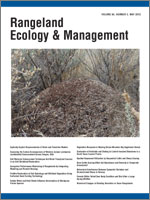A decrease in fire frequency and past grazing practices has led to dense mountain big sagebrush (Artemisia tridentata Nutt. subsp. vaseyana [Rydb.] Beetle) stands with reduced herbaceous understories. To reverse this trend, sagebrush-reducing treatments often are applied with the goal of increasing herbaceous vegetation. Mechanical mowing is a sagebrush-reducing treatment that commonly is applied; however, information detailing vegetation responses to mowing treatments generally are lacking. Specifically, information is needed to determine whether projected increases in perennial grasses and forbs are realized and how exotic annual grasses respond to mowing treatments. To answer these questions, we evaluated vegetation responses to mowing treatments in mountain big sagebrush plant communities at eight sites. Mowing was implemented in the fall of 2007 and vegetation characteristics were measured for 3 yr post-treatment. In the first growing season post-treatment, there were few vegetation differences between the mowed treatment and untreated control (P > 0.05), other than sagebrush cover being reduced from 28% to 3% with mowing (P < 0.001). By the second growing season post-treatment, perennial grass, annual forb, and total herbaceous vegetation were generally greater in the mowed than control treatment (P < 0.05). Total herbaceous vegetation production was increased 1.7-fold and 1.5-fold with mowing in the second and third growing seasons, respectively (P < 0.001). However, not all plant functional groups increased with mowing. Perennial forbs and exotic annual grasses did not respond to the mowing treatment (P > 0.05). These results suggest that the abundance of sagebrush might not be the factor limiting some herbaceous plant functional groups, or they respond slowly to sagebrush-removing disturbances. However, this study suggests that mowing can be used to increase herbaceous vegetation and decrease sagebrush in some mountain big sagebrush plant communities without promoting exotic annual grass invasion.
How to translate text using browser tools
1 May 2012
Vegetation Response to Mowing Dense Mountain Big Sagebrush Stands
K. W. Davies,
J. D. Bates,
A. M. Nafus
ACCESS THE FULL ARTICLE

Rangeland Ecology and Management
Vol. 65 • No. 3
May 2012
Vol. 65 • No. 3
May 2012
Annual grass
Artemisia Tridentate
Brush management
disturbance
forage
range improvements




